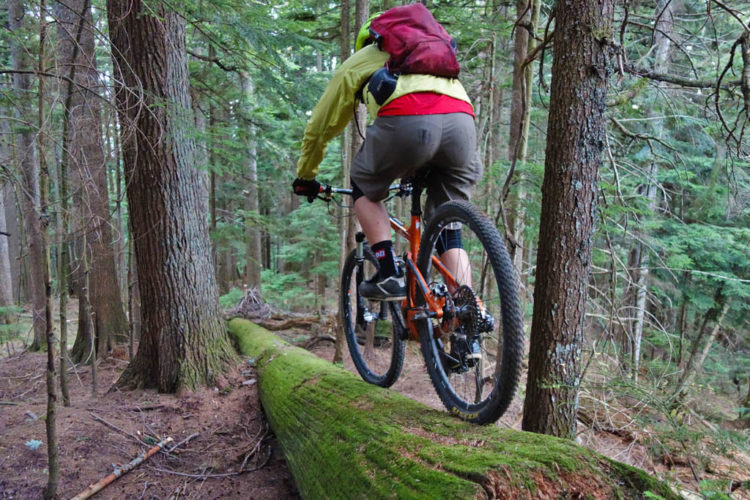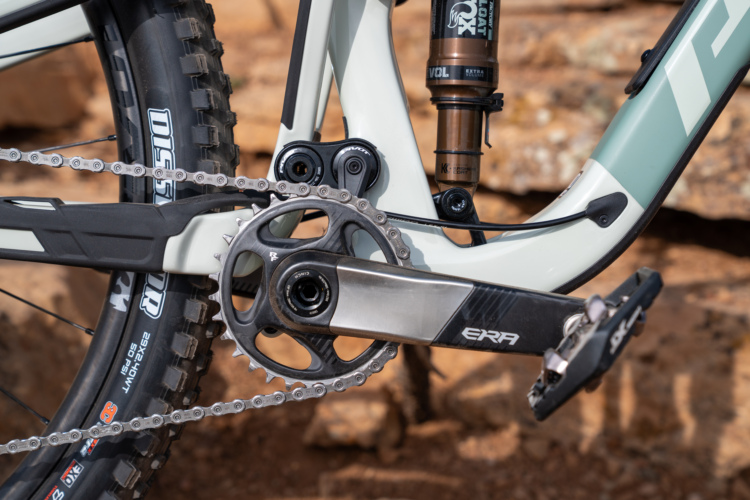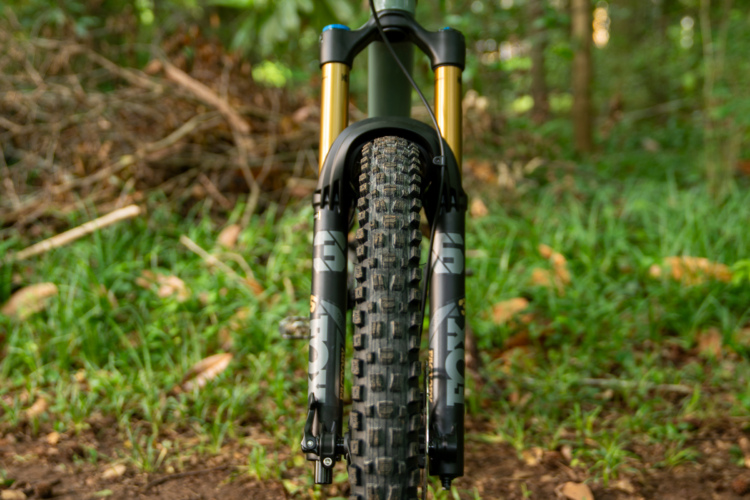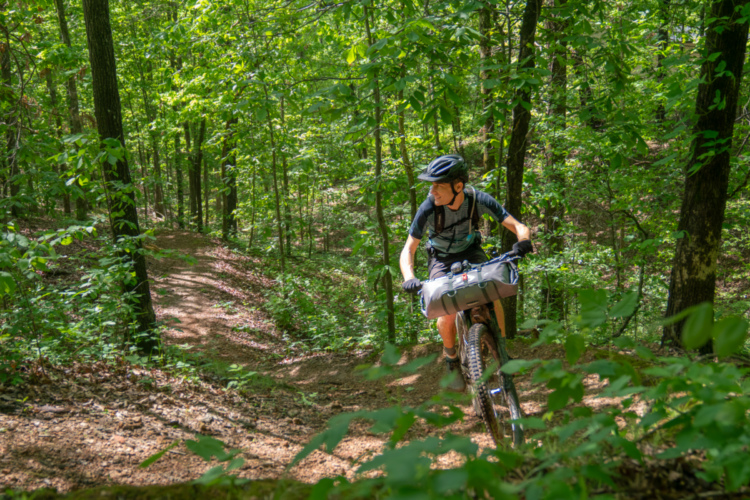
Like most of you, I am not a downhill racer. In fact, the thought of barreling down a steep line littered with rocks and roots often terrifies me. The first season I was invited to ride a downhill course with friends I declined, worried that I would not be able to keep up, or worse, that I would kill myself trying. As time went by, I realized that lift-served downhill mountain biking, or “DH”, isn’t so scary. Instead it is actually good practice for the trails I like to ride on a regular basis, or for building fitness and confidence on vacation epics such as the Whole Enchilada in Moab. Now, after riding two solid seasons of DH in Colorado, I cannot help but look back on how quickly my skills have progressed, and how much sharper my reflexes are.
I believe that almost anyone can benefit from the skills and muscle memory you acquire when your body is forced to focus on the intense variables that gravity throws at you. Here are five ways that DH mountain biking can make you a better rider, particularly if you are a novice or intermediate.
1. Getting Accustomed to Speed
For newer riders, speed is one of the most intimidating factors you’ll experience on a bike. Our bodies and minds are programmed to understand the consequences of failure as we go faster, and ironically, the fear of speed can lead to indecision that causes catastrophic consequences. It is a vicious cycle.
It is difficult to practice “speed.” For many riders, there may not be a lot of places to ride fast downhill. Sure, you might find a stretch of steep pavement to practice on, but it is not the same as weaving around obstacles on loose singletrack. Even in areas with mountains, riding fast downhill must be approached with caution due to the risk of encountering other trail users.
The beauty of true bike park DH riding is that typically there are no uphill users, allowing you to free your mind with one less thing to worry about, and concentrate on being comfortable going faster. Even if you are a relatively new rider, most resorts offer plenty of “green,” or beginner, trails that are relatively smooth and are devoid of jumps or other dangerous obstacles. In fact, many of them are designed for, and allow, children to ride, which is a great place to practice with the family or a timid partner. The most dangerous thing on these types of trails are the slower trail users themselves, so as you learn to ride faster, have respect for them and be careful.

2. Body Position and Technique
Learning proper body position is equally, if not more, important than riding fast. Unfortunately, it is difficult to learn certain moves until you can go fast enough on a bike to lean into turns, go off drops, and learn where to place your body over bumps and rollers.
Unlike some of your local trails, DH trails are made to go fast at a “trail speed,” and as long as you know that speed and where your body needs to be in relation to the bike, you will have a blast.
For example, it seems counter-intuitive, but often you need to shift your weight forward on the bike, especially in turns, to keep forward traction and momentum. It is equally important, in many situations, to keep your weight back over the rear tire when doing drops, or risk going over the bars on a landing. When jumping or riding faster over bumpy terrain, it is beneficial to maintain a neutral posture that allows you to move in any direction when something unexpected occurs. The more you ride DH, the more your body will learn these fine nuances, and translate them to any type of riding that you do anywhere else.

3. Learn How to Corner Faster and Maintain Speed
With improved body posture and speed, DH courses force riders to develop better cornerning techniques. When this is lacking, it becomes really obvious how much speed your scrub coming out of a turn, and it just feels wrong.
Riding downhill helps you learn to lean your body correctly, finding the right balance point on the bike to maintain traction as you pick up speed around a corner. You’ll learn to push the bike down and use the outside knobs of your tires, keeping your body in a position to “attack” the berm and actually gain speed. This is tough to do, and it takes a lot of practice, but when certain elements start to click, it opens up a whole new way to corner your bike.

Coming in high on a berm, for example, then leaning the bike into the turn, is something that will help you corner when going fast. Keeping your inboard knee low (like moto riders), and riding the top section of the berm produces giddy results when you rocket out the other side of the berm onto the trail. Using your bikes’s fork and shock as a force multiplier to push your bike out of the berm is one of the best feelings you can have on a bike. Period.
Especially in tight, twisty, banked turns, it is incredible to feel the speed you can gather coming out of these berms, while staying glued to the trail. Every bit of these techniques can be used on your local trails, and you may begin to see small banks in many corners to help you lean the bike. Look closely, they are there.

4. Progressive Jumps, Drops, and Rollers
Many riders are terrified to jump their bikes, and for good reason. However, mastering the bike in the air will not only make you a better rider, it will help you handle mistakes that may come along quickly, like hitting a bump on a new trail that shoots you into the air. Having the confidence, skill, and muscle memory to handle the bike in the air can save you from injury.
Practicing jumps on local trails can be fun, but may of them may not be built or maintained well. Chances are there are not very many of them unless you live in an area that supports this type of riding. One of the major advantages of riding DH parks is that the trails are littered with jumps of all shapes and sizes to practice on. Many parks offer progressive trails, where you graduate from easier to more difficult jumps by sessioning the same runs over and over until you master them–then move onto something harder.
[see_also id=”187023″][/see_also}

Think of it this way. First, you learn to jump off something relatively small like a curb, and when you are comfortable with that, you move onto something bigger. Imaging being able to hit a one foot ramp, then two feet, then three feet (and so on) at your own pace so that you incrementally gain confidence before you work yourself up to something like a six foot jump.
Not everyone has to, or needs to, hit big jumps… but it is nice to practice something over and over in a controlled environment until you progress to the level you want. DH parks are generally well maintained with a professional trail crew, which means that if you hit the jump or drop at the correct trail speed and utilize all of the other skills you’ve been working on to handle the bike at speed in the air, you’ll stick the landing carefully every time. The same cannot be said for two or three jumps that might exist on your favorite local trail, where blind corners, trail sabotage, or weather erosion may make jumping dangerous and eat away your confidence.

5. Repetition, Repetition, Repetition
One of my friends joked this season that a full day at a bike park, roughly 12-14 runs, is equivalent to all of the hard downhill riding we might do in an entire month in the Front Range of Colorado. He’s right. Most of the time I like to earn my turns, meaning that I enjoy the cardio workout of a long climb before I savor the reward of bombing back downhill. However, there is a lot of benefit to saving your energy for just the downhill portion, and doing it over and over again, practicing the skills we’ve already discussed.
Don’t be fooled: downhill riding is a different kind of workout. In fact, after riding hard all day at a downhill park you will feel incredibly tired, working muscles that do not get used as much on your local rides. If you ride hard enough, you might even feel like you are coming down with the flu.
Repetition builds muscle memory, and it reinforces what you have already been working on separately but did not realize it: going faster, jumping higher, and using your body to be more efficient. All of these things will help you stand up on the bike the next time you ride a long downhill section on any trail. Once your body and mind puts all of these things together, your are essentially practicing for all of the other rides that will come after it. You’ll be amazed at how much more fun your local trails are, how much more smoothly you ride them, and how features that once seemed challenging are more playful and uncomplicated.

Parting Advice
No matter what type of mountain bike riding you enjoy, taking a lift to ride and practice downhill can benefit anyone. If you really want to maximize your efforts, I would strongly suggest hiring a professional coach to help you refine all of your skills and help you ride safely. If you’re able to visit a DH park and ride fairly regularly, I would also encourage you to find a friend or friends that you trust who are better than you, and follow them as best you can. Watch how they approach obstacles and turns. Try to match their speed. Discuss with them how they approach certain features. Above all, ride within your ability and abide by the downhill code: pre-ride, re-ride, then freeride. DH riding can be done safely, but obviously there is a much higher chance of serious injury if you try to progress too quickly, or blindly ride trails that are not familiar to you. Armor and full face helmets are mandatory to avoid serious injury–we all fall down eventually.
There are dozens of bike parks in North America, and many more worldwide. Consider planning biking vacations to visit bike parks and work on techniques if you don’t live close to one. Bike parks offer instruction, rentals, and lodging. You do not need to have a dedicated downhill bike to enjoy many of these trails, but you should approach gravity resorts with a good bike in working order that you are comfortable with. Hopefully next season you can carve out some time and explore how DH can make you a better rider, whether you are a cross-country racer or aspiring gravity competitor. Regardless of your experience, have fun and be safe!












3 Comments
Nov 29, 2016
Nov 29, 2016
Nov 29, 2016